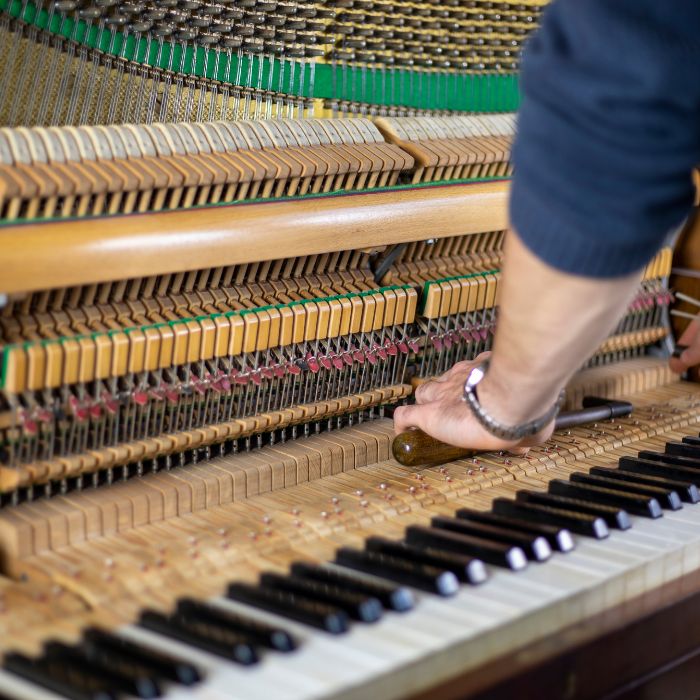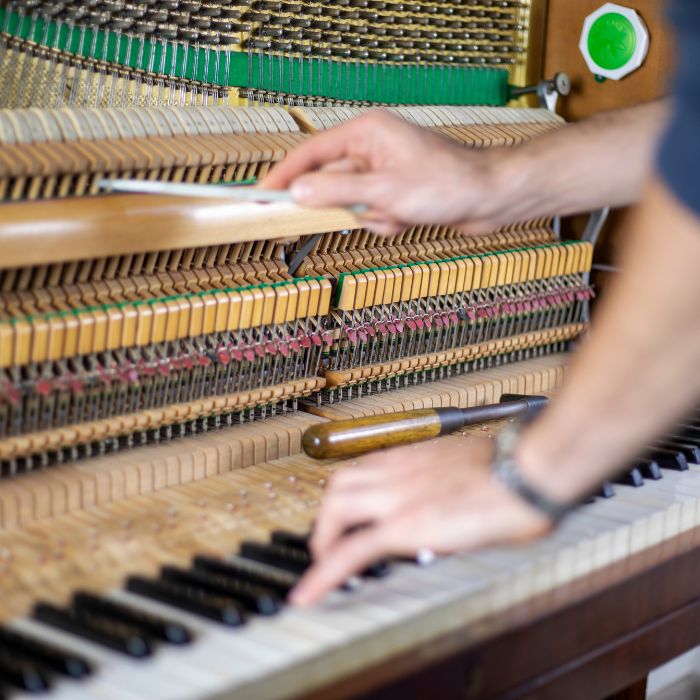How To Clean Piano Keys in 7 Steps & What Not to Do
Keeping your piano in optimal condition goes beyond tuning and maintenance - it also involves keeping out the dust and dirt. Piano keys, in particular, require special attention and I can still the sound of my mom cleaning our piano keys.
In this how to clean piano keys guide, we'll show you how to keep your keys clean, maintain their appearance and and prevent the buildup of dirt and grime on and in between keys.
Let's get started!
How To Clean Piano Keys - Step by Step
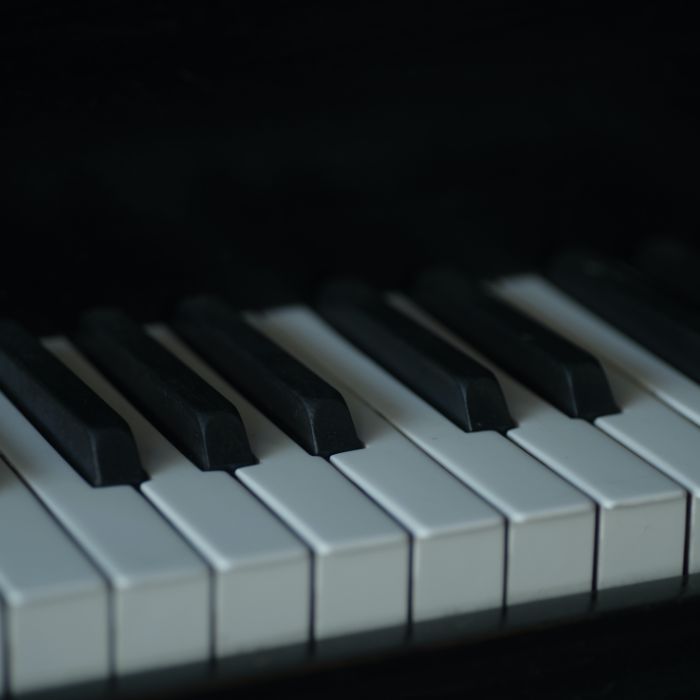
Before we get started into the real, step by step guide, I thought I would just tell you what I do. It's very simple. All I do is dust my keys - each piano key really - once a week. I just move from the back of the keyboard (near where you'd keep your music) to the front of the keys and make my way down the keyboard.
It takes about one minute.
The process below, using a mild soap, is something I've never had to do as my keys. At most, I've had to use a slightly damp cloth. So keep that in mind.
If your piano keys need some vigorous cleaning, the process below is helpful but for everyday cleaning, dusting may be all that you need.
Step by Step Piano Key Cleaning
Step 1: Gather the Necessary Supplies
Before beginning the cleaning process, gather the following supplies:
- a soft, lint-free cloth
- mild soap (some use dish soap) or piano key cleaner
- distilled water (or regular water if that's all you have)
- a small bowl
- cotton swabs.
Step 2: Prepare the Cleaning Solution (Optional)
If you think your piano keys will need more than a dry cloth or damp cloth to come clean, you can create a cleaning solution for your keys.
In a small bowl, dilute a small amount of mild soap or piano key cleaner with distilled water. Some use dish soap (although I haven't personally) and create a solution of 1 part dish soap to 4 parts water.
Avoid using harsh chemicals or excessive moisture, as they can damage the keys.
Step 3: Remove Dust & Debris
Using a soft cloth, gently dust the keys to remove any loose particles or debris. Start from one end of the keyboard and work your way to the other, using a light touch to prevent scratching the keys.
Note that this may be all you really need to do to clean your keys.
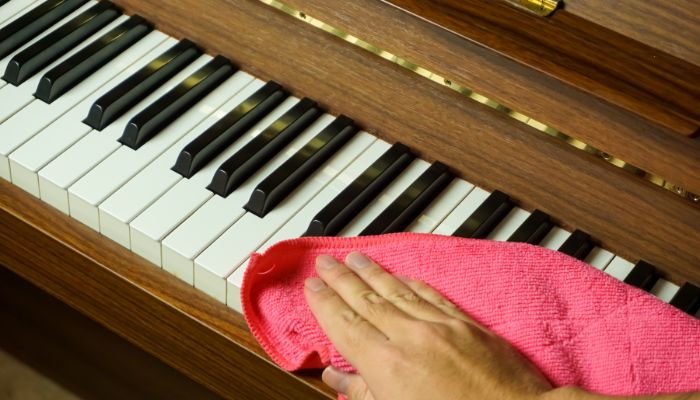
Step 4: Clean the Keys
Dip a clean cloth or a cotton swab into the cleaning solution you prepared earlier. Wring out all excess liquid to avoid oversaturation. Gently wipe each key, starting from back by the keyboard out towards yourself.
You really don't want to get much water or soap residue on the keys so keep as much water out as you can. You don't want your wood to swell and the tuning to go out.
You may want to do a second wipe with just a damp cloth to get any soap residue off.
Step 5: Dry the Keys
After cleaning, use a dry, soft cloth to wipe away any remaining moisture from the keys. Be sure that no moisture is left behind to prevent damage or warping of the keys.
Step 6: Regular Cleaning & Maintenance
It's a good idea to dust your keys regularly to keep things from falling in between the cracks.
If you have children that love to bang on the piano with sticky fingers, giving it a good wipe now and then is also a great idea.
I find the biggest problem I have is little things falling in between keys so whatever you can do to minimize that is great.
Step 7: Keep It Covered
The final part of this is keeping your piano keys covered if you can. So keep the lid down if you have one, place a soft cloth on your keys, or do what you can to keep the dust out.
What Not To Do When Cleaning Piano Keys
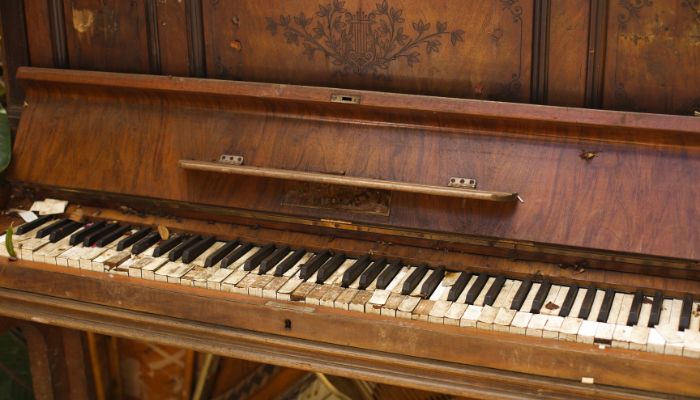
When cleaning piano keys, there are several things you should avoid to prevent any damage or discoloration. Here are some key points to keep in mind:
- Harsh Chemicals: Avoid using strong chemicals or abrasive cleaners on piano keys. They can damage the surface of the keys, strip away their finish, or cause discoloration. Stick to mild soap specifically designed for piano key cleaning or recommended by the manufacturer.
- Excessive Moisture: Do not use excessive moisture when cleaning piano keys. Moisture can seep between the keys and cause swelling or warping. It's important to wring out any excess liquid from your cleaning cloth or cotton swab to prevent oversaturation.
- Scrubbing or Rubbing Vigorously: Piano keys are delicate, and excessive scrubbing or rubbing can scratch or damage the surface. Always use a gentle touch and avoid applying too much pressure.
- Using Rough or Abrasive Materials: Stay away from abrasive materials like rough sponges or scouring pads when cleaning piano keys. They can leave scratches or marks on the keys. Stick to soft, lint-free cloths or cotton swabs for a safe and gentle cleaning process.
- Allowing Excessive Drying Time: After cleaning, ensure that the keys are completely dry before closing the keyboard cover or using the instrument. Leaving moisture on the keys for an extended period can lead to damage or discoloration.
Remember, if you are unsure about cleaning your piano keys or encounter stubborn stains or marks, it's best to consult a professional piano technician or seek advice from the piano manufacturer. They can provide guidance on proper cleaning methods and recommend suitable products to ensure the longevity and beauty of your piano keys.
You're Ready to Clean Your Piano!
Cleaning piano keys is a simple yet crucial part of piano maintenance. By following these steps and using the proper supplies and techniques, you can keep your piano keys looking and feeling their best.
Remember to be gentle, avoid harsh chemicals, and regularly dust your piano keys to maintain their cleanliness and longevity. With a well-maintained instrument, you'll not only enjoy better aesthetics but also a smoother playing experience.
Recent Articles
-
Piano Notes Chart
Nov 20, 23 10:21 PM
Find a piano notes chart for treble clef and bass clef notes as well as the different types of notes. -
D Chord on Piano + Diagram, How To & Theory
Oct 24, 23 12:20 AM
Learn how to play the D chord on piano with diagram, fingering, D/A, D/F# and a theory explainer. -
Diminished Piano Chords: Chart & How to Make Them
Oct 09, 23 09:23 PM
Learn the different diminished piano chords and how to make them. Here you'll find both a diminished chord chart and an explanation.
- Home
- Keyboard Buying Guide
- How to Clean Piano Keys
Free Download:
Ultimate Chord Cheat Sheet
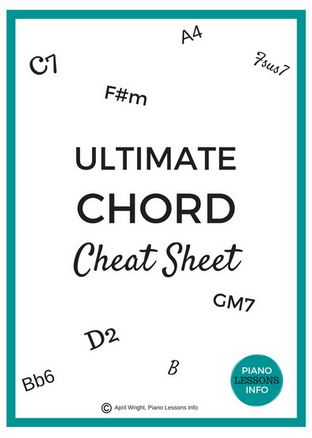
Subscribe below and get free access to the (printable) Ultimate Chord Cheat Sheet.




